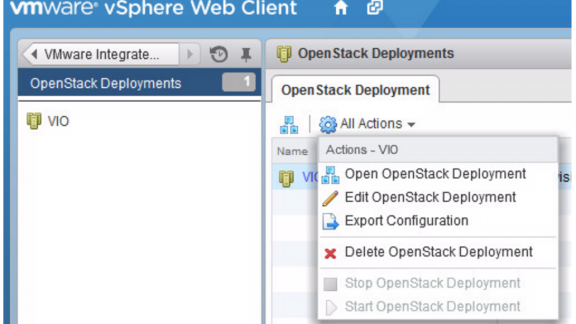A version of VMware Integrated OpenStack was released in April, and for the DevOps team, the Cloud API did not change from one vendor to another. So, how does it impact me as a vSphere administrator?
This article will go through how VIO can be managed through the vSphere Web Client.
After deploying the VIO cluster services instance, this is what I have noticed:
One Single Pane of Glass
Yes, the initial OVA deployment involves the registration of the VMware Integrated OpenStack services to vCenter Service, so there is no surprise to see the OpenStack logo on the vSphere Web Client.
Instead, I find it very practical to be able to configure all the services through the same vSphere Web Client.
Backup and Restore Configuration File
I like this feature in particular, if you are like me, someone who is constantly multitasking, it is really a gain of time when you have to redeploy the OpenStack services or troubleshoot any deployment issue.
The installation requirements can be found on this article: http://blogs.vmware.com/openstack/vmware-integrated-openstack-first-look/
It is quite an exhaustive list, and it can save a lot time especially when you have to fill the IP range.
Managing the VIO OpenStack Management Cluster
Depending on the business demand, you can scale-up and scale-down your Nova Compute or other storage configurations from your actual setup within the VMware Integrated OpenStack web interface.
You can:
- Get the summary of OpenStack Services cluster
- Add new Nova Compute
- Add new Nova Storage
- Add new Glance Storage resources
- Eventually patch your OpenStack Cluster
High Availability (HA)/Disaster Recovery Services (DRS) Rules
VMware has designed an OpenStack architecture in high availability mode, but does it integrate with the vSphere HA or DRS? In this example, during the OpenStack services cluster deployment, DRS rules get created to ensure the same OpenStack Service virtual machines are not hosted on the same VMware ESXi host.
Once configured, the things you need to remember are:
- DevOps will provision daily virtual machine workload. You need to make sure you have some controls, monitoring and alarms set on the vSphere infrastructure to prevent any massive production disruption, e.g., a case where a virtual machine provisioning script keeps running in a loop … and might impact the full vSphere environment.
- Maintenance. For application awareness, you need to go through the vSphere VMware Integrated web plugin and shut down the cluster from there, not from the vSphere web virtual machine inventory, as it has no application dependency awareness.
- We are providing a validated VIO architecture. If you are customizing OpenStack services virtual machines manually, I would suggest backing up the virtual machines and calling support if needed to validate it – as with any future upgrade, your configuration might be overwritten and not persistent.
Julienne Pham is a Technical Solution Architect for the Professional Services Engineering team. She is specialised on SRM and core storage. Her focus is on VIO and BCDR space.








